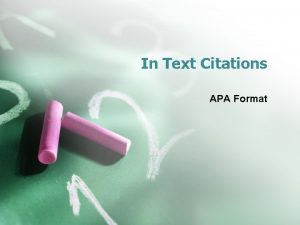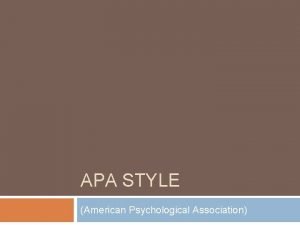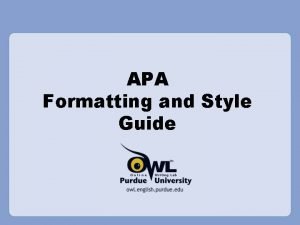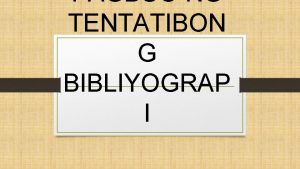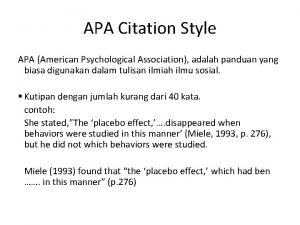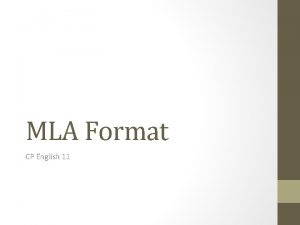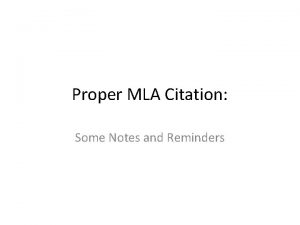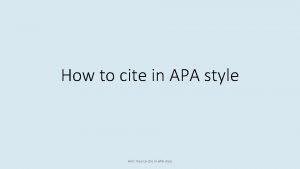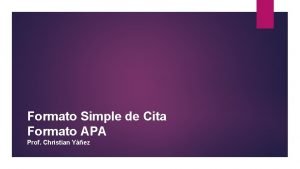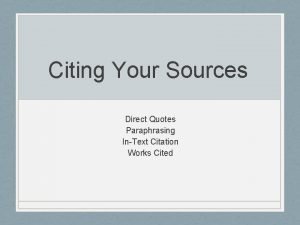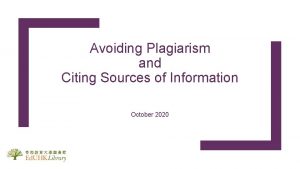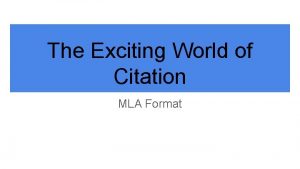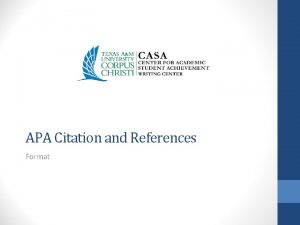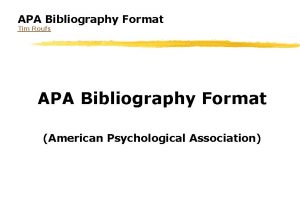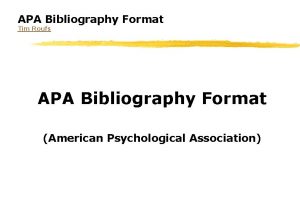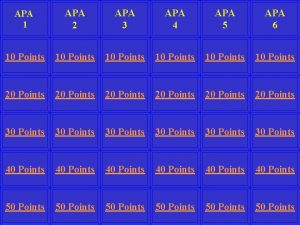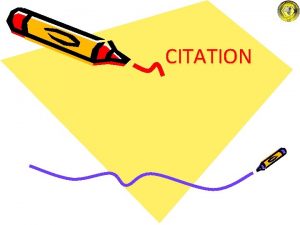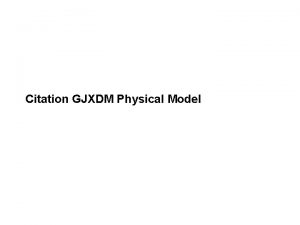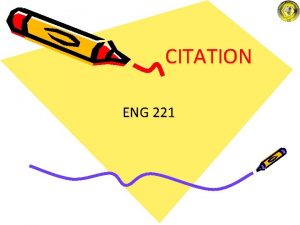The Exciting World of Citation APA FORMAT AMERICAN















- Slides: 15

The Exciting World of Citation APA FORMAT

AMERICAN PSYCHOLOGICAL ASSOCIATION (APA) There are 2 main documentation styles used in academics: APA format and MLA format. The following subject areas use APA format: ▪ social sciences (psychology, sociology, anthropology, linguistics, criminology, economics) ▪ business ▪ nursing

Requirements for APA Format Every time a person does research, they must include TWO things: 1) A full reference list of where to find the work where the idea was borrowed (often called a “References” list), AND 1) an indication of which ideas in the written work were borrowed from someone else (often called embedded citations) You’ll notice that I underlined the word idea above. That is because you must acknowledge what information presented in your work is in fact borrowed, even if you change the words (also known as paraphrasing).

Two Requirements for APA Format: #1: Providing a List of All Sources For your assignments in social science, and according to APA format, you will provide a “References” list every time you do research. A References list is a list of sources (also called “citations”) that you used to create your essay, report, presentation, etc. When you submit your final product, it is included on its own separate page at the end of the essay, report, written speech, etc.

Features of a References List ▪ It is a list that must be on a separate page from the written assignment. ▪ When submitting your assignment, the References list is stapled/attached to the back of the good copy of the essay. When submitting a digital copy, it should be the final page of the document. ▪ The title at the top of the page should simply read, References. ▪ The first line of your citation should be flush to the left. The second and third lines of each citation should be indented. ▪ The list should NEVER contain bullets or numbers. The order of the sources is by alphabetical order by the first letter of each citation, whether or not there is an author or only the name of an organization. So, what does a references list look like? Follow this basic format, paying attention to punctuation: Author, A. (date). Title of page. Title of website. Retrieved from http: //xxxxx

References Canada’s Crime Rate: Two Decades of Decline. (2014). Statistics Canada. ca. Accessed 5 Nov. 2014. Retrieved from http: //www. statcan. gc. ca/pub/11 -630 -x 2015001 -eng. htm Cohen-Rimmer, E. (2016). How to Survive Math. The World According to Elah. Accessed 20 October 2016. Retrieved from www. e. cohen-rimmer. com Gauci, C. (2015). Why Volleyball is the Best Sport. The Life of an Athlete. Accessed 25 October 2016. Retrieved from www. s. coopersmith. com Tchekalin, A. (2016). Can Someone Just Choose My Topic For Me? Please? The Struggle to be Decisive. Accessed 7 August 2016. Retrieved from www. a. tchekalin. com Zulueta, N. (2016). Look Deep into my Phone. How to Make your Teacher Look Foolish with 5 Different Apps. Accessed 6 November 2016. Retrieved from www. n. zulueta. com

References List Construction Technically speaking, for each citation, you need the following information in the order it’s presented here: ▪ ▪ ▪ author’s surname, comma, first initial of the author’s given name, period. date of publication/date of last revision/date of posting in brackets, period. website article title, period. title of the overall website in italics, period. the date you accessed the website URL Notice the indentation in the example and that it is alphabetized by the first letter of each citation. If there is no author, you use the first letter of the article name to alphabetize. Pay close attention to the punctuation throughout.

References Construction There are many websites that will help you create the citations, but you still have to make sure it’s done correctly: ▪ Google Docs ▪ Easy Bib ▪ Bibme. com There are several sites online to help you generate citations. If you want to consult a website for specific details about how to create embedded citations and a References list, go to Owl Purdue.

How to create rough notes For Process #1, you are required to submit your rough notes from research. You should follow the following format: Freitas, N. (2015, January 6). People around the world are voluntarily submitting to China’s Great Firewall. Why? Slate Magazine. Retrieved from http: //www. slate. com/blogs/future_tense/2015/01/06/ ● legislative actions and technologies to regulate the Internet ● blocks access to particular foreign websites ● the Chinese government sees this as “Internet sovereignty” You should repeat this until you have a minimum of 5 pages and 5 good quality sources

Am I done yet? No. We have only covered References which is one of the two requirements of APA format. When you are starting to write your rough draft of your essay, report, or presentation, that is when you will need the information from your References list to create the second thing you must include to avoid plagiarism. Next slide…

Direct Quote vs. Paraphrasing When doing research, much of what we write is a mix of paraphrasing with some direct quotes. Direct Quote Paraphrasing ▪ When you include sentences or phrases that are copied exactly as they are written or said from your source ▪ When you summarize the borrowed ideas in your own words ▪ Quotation marks around the copied phrase or sentence(s) are required ▪ Quotation marks are not required NOTE: See the class website for a link that explains when it is best to directly quote and when it is best to paraphrase. In general, you will want to paraphrase shorter works of writing, as in the case with letters and diary entries.

Back to the Two Requirements for APA Format: #2: Acknowledging Borrowed Work in Your Written Work Technically speaking, you must communicate to the reader (your audience: me) which sentences contain an idea that is borrowed from research that you have conducted. You must do this by providing what is called: ▪ parenthetical citations ▪ in-text citations ▪ embedded citations Those are just three names that all describe the same thing. I will be using “embedded citations” from here on out. You must provide an embedded citation within the text of your research essay at the end of a direct quote, paraphrased sentence, or statistic. The embedded citation communicates to your audience that the information in that sentence is borrowed and not an original idea from you. Any assignment requiring research will have several embedded citations from a variety of sources in every body paragraph.

So, what does an embedded citation look like? An embedded citation includes the author’s last name and year of publication (for books/magazines) or year of last revision (in the case of websites) in parentheses (also sometimes called “brackets”) at the end of a sentence before the period. For example, if you borrowed something that Ms. Gourley wrote, you would paraphrase it and include the embedded citation at the end of the sentence like this: Studying social sciences helps people develop two very important skills for any career: communication skills and analytical skills (Gourley, 2017). You will notice that there is punctuation within the embedded citation (i. e. a comma after my last name). You will also note that the period is at the end of the second/closing parenthesis.

Embedded Citations for Websites You will likely be looking at websites which means there won’t be page numbers. For websites, you will only have to include the author(s). Since different sources have different characteristics, use this as a general guide: How do I create an embedded citation that is from an Internet site and therefore, has no page number? Just include the author’s last name in parentheses. (Gourley). How do I create an embedded citation that is from an Internet site and has no author because the site was created by an organization? Move the title of the website in front of the date. If the title is very long, just put in a couple key words in the parentheses. (Kids Help Phone). How do I create an embedded citation that is from an Internet site and has no author because the site was created by the government? Just put in the government department in parentheses. (Statistics Canada).

Will I have an embedded citation at the end of every sentence in my assignment? That depends… ▪ If it takes you 2 or 3 sentences to express ONE IDEA, you can include the embedded citation at the end of the second or third sentence. ▪ If you write a sentence that contains common knowledge, you do not need to provide an embedded citation. How do you know what is common knowledge? Ask yourself if someone living in Chad, Greenland, Turkmenistan, and Sri Lanka would all know the idea you are expressing to be fact. If your answer is “yes”, you don’t need to provide an embedded citation. ▪ Common knowledge cannot just be what you and your friends or people in Malaysia believe to be true. Even after reading the above, when in doubt: ▪ Give an embedded citation. Cover yourself. It’s better to over-cite than to under-cite which is quite simply plagiarism. ▪ Ask your teacher. It’s kind of what they do for a living. They’re there to help you!
 Apa format website no author
Apa format website no author How to use in text citations apa
How to use in text citations apa Intext citation with multiple authors
Intext citation with multiple authors Bibliograpi ng aklat
Bibliograpi ng aklat American psychological association (apa) style adalah
American psychological association (apa) style adalah Mla in-text citation website
Mla in-text citation website Mla citation format
Mla citation format Chinese name apa citation
Chinese name apa citation Cite a website no author apa
Cite a website no author apa Apa format website no author
Apa format website no author Generador de bibliografia apa
Generador de bibliografia apa Comma before a quote
Comma before a quote Citing
Citing Apa intext citation 3 authors
Apa intext citation 3 authors How to reference two authors apa
How to reference two authors apa What's font
What's font
